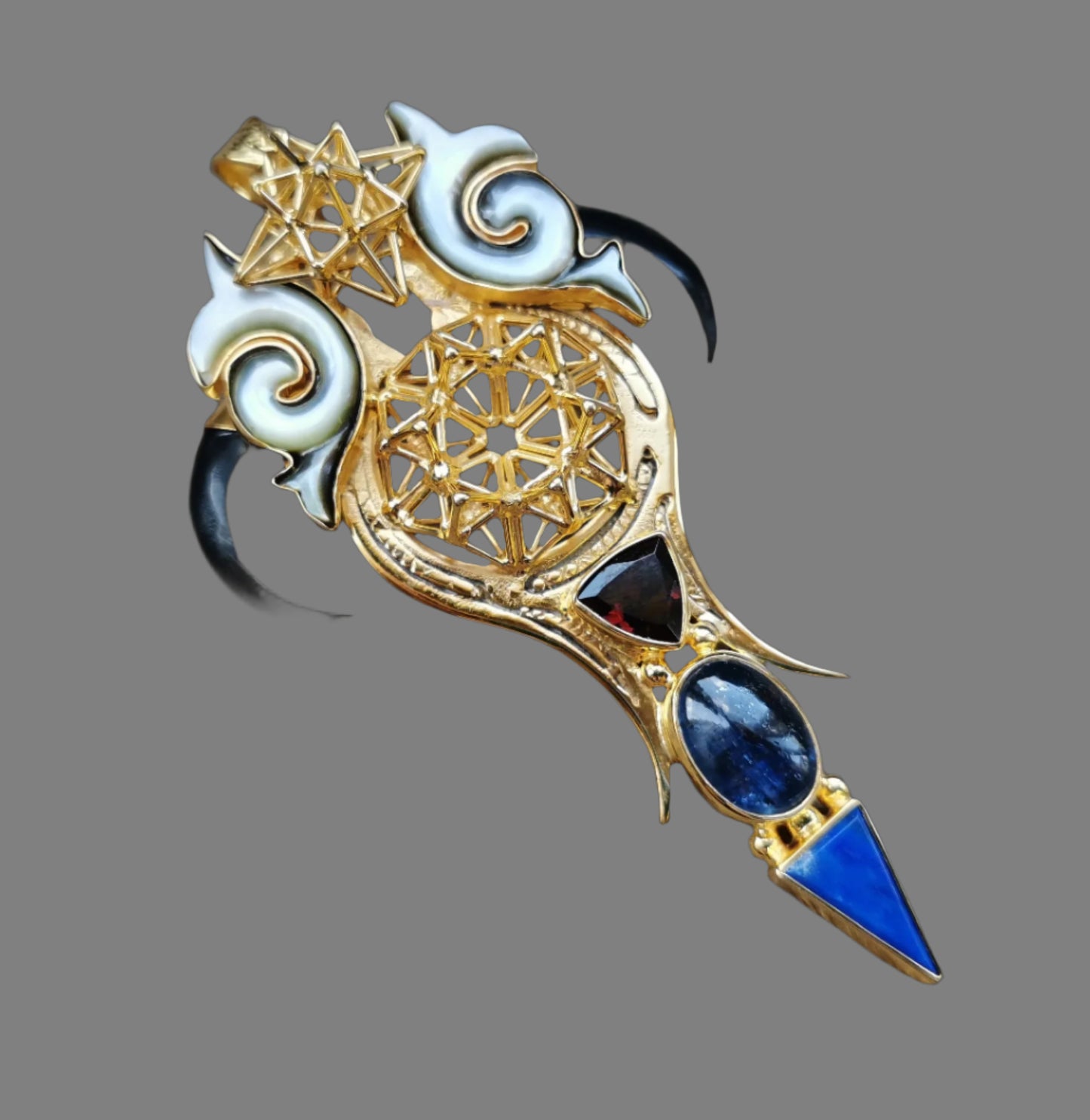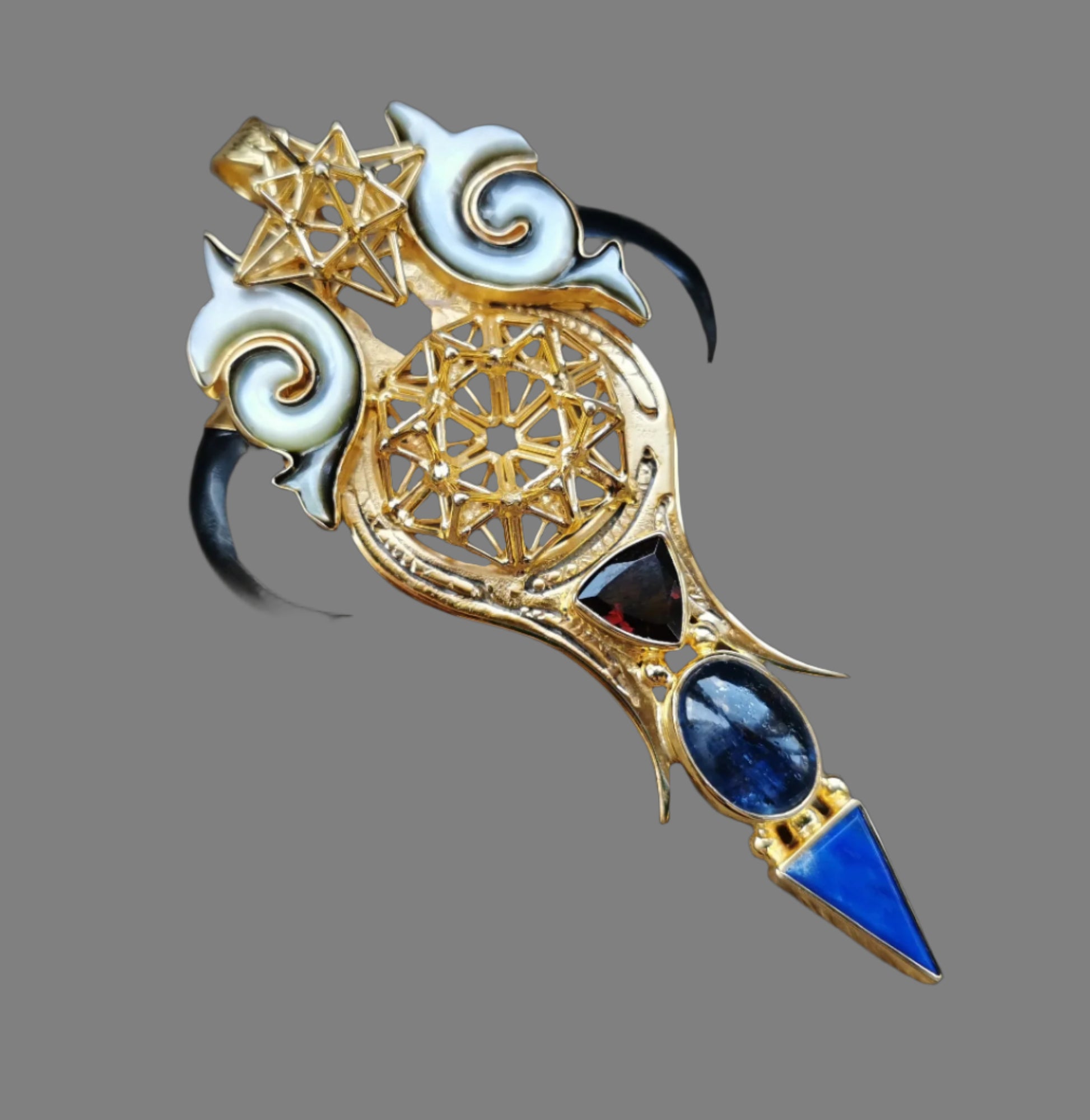Portal Glastonbury
Ref.PD1059
Ref.PD1059
Couldn't load pickup availability
Ref.PD1059 - Gold plated on silver pendant with Heart Star & Hyper Tetra Torus geometries, mother of pearl carved Tibetan clouds, ecologically sourced buffalo horn carved hawk claws, garnet, polished kyanite, and lapis lazuli gemstones.
This pendant was designed for manifestation and success with the intention to share benefits.
The hawk, with its keen eyesight, soaring flight, and predatory prowess, holds profound symbolic and spiritual significance across cultures, embodying themes of vision, freedom, strength, and heightened awareness. Its commanding presence in the skies and sharp instincts make it a powerful emblem in both symbolic and spiritual contexts.
Symbolic Significance
At its core, the hawk symbolizes vision and clarity. Its extraordinary eyesight, capable of spotting prey from great distances, represents the ability to see the truth or perceive details others miss. This makes it an emblem of insight, foresight, and perspective, encouraging a broader view of life’s challenges or opportunities. The hawk’s high-altitude flight reinforces this, symbolizing detachment from mundane concerns to gain a “big picture” understanding.
The hawk’s swift, decisive flight embodies freedom and independence. Soaring through the skies, it represents liberation from constraints, urging one to rise above limitations and pursue goals with focus and determination. Its solitary nature often underscores self-reliance, symbolizing inner strength and confidence in navigating life’s currents alone when needed.
Strength and precision are also key. As a skilled hunter, the hawk symbolizes efficiency and strategic action, striking with purpose. This reflects the importance of timing and decisiveness, encouraging one to act boldly when opportunities arise while maintaining discipline and focus.
The hawk’s connection to the air element ties it to intellect and communication. Its ability to ride thermals suggests harnessing unseen forces—ideas, instincts, or energies—to achieve goals, symbolizing adaptability and resourcefulness in dynamic environments.
Spiritual Significance
Spiritually, the hawk is often seen as a messenger or guide, bridging the earthly and the unseen. Its lofty flight and piercing gaze associate it with heightened awareness, urging spiritual awakening and attentiveness to subtle signs or intuitions. In many traditions, a hawk’s appearance is thought to signal a call to focus, align with one’s purpose, or heed inner wisdom, acting as a reminder to stay vigilant on one’s spiritual path.
The hawk’s predatory nature ties it to transformation. By hunting, it clears the old to make way for the new, symbolizing the release of outdated patterns or beliefs to foster growth. This aligns with its role as a guide through transitions, helping one navigate change with clarity and courage.
In some cultures, the hawk represents guardianship and protection. Its watchful presence in the sky suggests an overseeing force, not divine but instinctual, encouraging trust in one’s ability to protect personal boundaries or values. This protective aspect also ties to leadership, as the hawk’s commanding presence inspires confidence and authority.
The hawk’s connection to the sun, often soaring in bright skies, evokes vitality and illumination. It symbolizes the pursuit of truth and enlightenment, urging one to seek clarity and embrace the light of self-awareness over ignorance or illusion.
Cultural Contexts
In Native American traditions, hawks are revered as messengers and visionaries, often linked to leadership and spiritual insight. They’re seen as guides for warriors or seekers, carrying messages from the spirit world.
In ancient Egyptian culture, the hawk’s solar ties made it a symbol of power and vigilance, associated with keen observation and authority.
In Celtic lore, hawks represent nobility and precision, their flight inspiring tales of heroism and clear-sightedness.
In modern contexts, hawks often symbolize ambition and focus, as seen in phrases like “hawk-eyed” for sharp perception.
The hawk’s symbolic and spiritual significance weaves together vision, freedom, strength, and transformation. It embodies the power of clear sight, decisive action, and spiritual alertness, urging one to rise above, trust instincts, and navigate life’s transitions with courage and precision. As a creature of sky and sun, it inspires pursuit of truth, self-reliance, and alignment with one’s highest potential.
Hyper Tetra Torus aka 5D Hyper Toroidal Tetra
This, as a frozen position, toroidal fractal implies the movement of tetrahedrons through a central vortex.
These circling tetrahedrons are all connected to the member, either side of them as well as all other members through the center.
The tetrahedron (we call Pyra sphere) is the shape that most represents individuality – also desire, creativity, passion, birth and life force. The tetrahedron is also the geometric seed representation that begins the process of creation of all forms. In its Hyper representation it also reveals the simultaneous oneness and individuality.
In other word it is a level of realization of a oneness with everything that does not require annihilation of the self.
Oneness in Love: love requires two and yet joins those two (or many) as one.
Heart Star
Magnetic
Love and compassion, emotional balance, the healing of abandonment and betrayal.
The Heart Star, the central fractal within the Human hologram, forms a junction through which all systems of the Human matrix are interwoven. Within the Covenant embedded in the Human matrix the Heart Star fractal is the fulcrum point through which we embody the Benevolence of Creation. It is in frequency resonance with the Heart chakra, facilitating the cleansing of the emotional body.
The Heart Star brings Stellar Radiance into resonance with the central fractal of the Human matrix, in addition to the benefits of the Iconic Terra Prana Sphere which forms its centre.
This form protects against unbalanced electric energies, e.g., computers, televisions, etc.
Clouds, as natural phenomena, carry rich symbolic significance across cultures, art, literature, and psychology, shaped by their transient forms, ethereal nature, and role in weather patterns. Their symbolism focuses on human experiences, emotions, and natural cycles.
1. Transience and Impermanence
Core Symbolism: Clouds are ever-changing, forming and dissolving quickly, making them a universal symbol of impermanence and the fleeting nature of life, emotions, or moments.
Cultural Contexts:
In Buddhism, clouds embody anicca (impermanence), illustrating that all things pass, like clouds drifting across the sky, encouraging mindfulness of the present.
In Japanese haiku and art, clouds evoke mono no aware, a bittersweet appreciation of life’s ephemeral beauty, capturing fleeting moments.
Example: In poetry, a drifting cloud might symbolize a transient emotion, urging one to cherish the moment before it fades.
2. Mystery and the Unknown
Core Symbolism: Clouds obscure the sky, hiding what lies beyond, symbolizing mystery, ambiguity, or the unknown. Their shapeshifting forms spark imagination and subjective interpretation.
Cultural Contexts:
In Western art (e.g., Romantic landscapes), clouds create atmospheric depth, suggesting unexplored realms or introspective uncertainty.
In psychology, clouds in dreams or art therapy may represent unclear thoughts or unresolved questions, their forms open to personal meaning.
Example: The phrase “head in the clouds” reflects dreaminess or detachment, tying clouds to the intangible realm of ideas and possibilities.
3. Emotion and Mood
Core Symbolism: Clouds mirror emotional states, with their appearance—dark storm clouds or fluffy white ones—reflecting human moods or inner turmoil.
Cultural Contexts:
Dark clouds symbolize sadness, anxiety, or looming challenges, as in the idiom “a cloud over one’s head” or literary storms foreshadowing conflict.
White, fluffy clouds evoke calm, hope, or contentment, often seen in pastoral poetry or serene landscapes to convey peace.
In modern storytelling, clouds set emotional tone, like ominous clouds in film signaling tension or bright skies suggesting optimism.
Example: In Wordsworth’s “I Wandered Lonely as a Cloud,” clouds convey solitude and introspection, aligning with the poet’s emotional journey.
4. Transformation and Renewal
Core Symbolism: Clouds drive the water cycle, bringing rain to nourish the earth, symbolizing transformation, renewal, and growth. They represent potential for change after hardship.
Cultural Contexts:
In Indigenous cultures (e.g., Native American or African traditions), clouds are life-givers, with rain symbolizing abundance and the sustenance of crops or communities.
In philosophical thought, clouds reflect adaptability, their fluid forms symbolizing the ability to evolve through life’s cycles.
Example: A rain cloud ending a drought in folklore symbolizes hope and rejuvenation, transforming barren land into fertile ground.
5. Freedom and Boundlessness
Core Symbolism: Clouds drift freely across the sky, unbound by earthly limits, symbolizing freedom, imagination, and limitless potential.
Cultural Contexts:
In Romanticism, clouds inspired creativity, as in Shelley’s “The Cloud,” where they embody boundless energy and poetic vision.
In modern culture, cloud-watching—seeing shapes in the sky—symbolizes childlike wonder and creative freedom, unburdened by constraints.
Example: The phrase “chasing clouds” suggests pursuing dreams or aspirations without boundaries, evoking a sense of liberation.
6. Obscurity and Burden
Core Symbolism: Dense or stormy clouds symbolize obscurity, confusion, or emotional burdens, blocking light and clarity.
Cultural Contexts:
In literature, clouds often foreshadow challenges, like storm clouds gathering before a narrative climax, amplifying tension.
In modern idioms, “every cloud has a silver lining” implies that even difficulties hold potential for hope or resolution.
Example: In visual media, dark clouds over a scene suggest emotional weight or impending struggle, creating a mood of uncertainty.
Practical and Cultural Contexts
Art and Literature: Clouds are versatile symbols in creative works. Impressionist paintings (e.g., Monet’s skies) capture their fleeting beauty, symbolizing the passage of time, while Gothic novels use stormy clouds for atmospheric tension.
Weather Symbolism: In folklore and meteorology, clouds predict change—cirrus clouds signal fair weather, while cumulonimbus warn of storms, reflecting life’s unpredictability.
Modern Culture: Clouds inspire metaphors in technology (e.g., “cloud computing” for accessible, intangible data) and music (e.g., Joni Mitchell’s “Both Sides Now,” exploring life’s dualities through clouds).
Psychological Practices: In mindfulness or therapy, clouds symbolize passing thoughts, drifting away to reveal mental clarity, encouraging emotional detachment.
Variations Across Cultures
Western Traditions: Clouds often reflect emotional or narrative shifts, as in Romantic poetry where they evoke solitude or in novels where stormy skies signal conflict.
Eastern Traditions: In Chinese and Japanese art, clouds are aesthetic motifs (e.g., ukiyo-e prints), symbolizing nature’s transient beauty and cyclical flow.
Indigenous Perspectives: Many Indigenous cultures view clouds as sources of life, with rain symbolizing communal prosperity and environmental balance.
African Traditions: Clouds are tied to agricultural cycles, representing hope and sustenance through rain, central to community survival.
Conclusion
Clouds symbolize transience, mystery, emotion, transformation, freedom, and obscurity, resonating as metaphors for human experiences and natural cycles. Their fluid forms reflect life’s impermanence, emotional landscapes, and potential for renewal, while their boundless drift evokes imagination and liberation. Across cultures, clouds inspire introspection and creativity, from poetic musings on change to artistic depictions of mood and hope. As symbols of both burden and possibility, they capture the complexity of existence in a secular, universal way.
Size: 105mm/4.13in approx.


